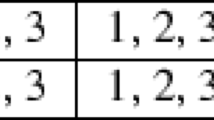Abstract
Let \({\mathcal{F}}\) be a (0, 1) matrix. A (0, 1) matrix \({\mathcal{M}}\) is said to have \({\mathcal{F}}\) as a configuration if there is a submatrix of \({\mathcal{M}}\) which is a row and column permutation of \({\mathcal{F}}\). We say that a matrix \({\mathcal{M}}\) is simple if it has no repeated columns. For a given \({v \in \mathbb{N}}\), we shall denote by forb\({(v, \mathcal{F})}\) the maximum number of columns in a simple (0, 1) matrix with v rows for which \({\mathcal{F}}\) does not occur as a configuration. We say that a matrix \({\mathcal{M}}\) is maximal for \({\mathcal{F}}\) if \({\mathcal{M}}\) has forb\({(v, \mathcal{F})}\) columns. In this paper we show that for certain natural choices of \({\mathcal{F}}\), forb\({(v, \mathcal{F})\leq\frac{\binom{v}{t}}{t+1}}\). In particular this gives an extremal characterization for Steiner t-designs as maximal (0, 1) matrices in terms of certain forbidden configurations.
Similar content being viewed by others
References
Alon N., Krivelevich M., Sudakov B.: Induced subgraphs of prescribed size. J. Graph Theory 43, 239–251 (2003)
Anstee R.P.: personal communication.
Anstee R.P., Barekat F.: Design Theory and Some Non-simple Forbidden Configurations, preprint.
Anstee R.P., Keevash P.: Pairwise intersections and forbidden configurations. Eur. J. Comb. 27, 1235–1248 (2006)
Anstee R.P., Sali A.: Small forbidden configurations IV. Combinatorica 25, 503–518 (2005)
Anstee R.P., Griggs J.R., Sali A.: Small forbidden configurations. Graph. Comb. 13, 97–118 (1997)
Babai L., Frankl P.: Linear Algebra Methods in Combinatorics. Preliminary Version 2. University of Chicago (1992).
Dehon M.: On the existence of 2-designs S λ(2, 3, v) without repeated blocks. Discret. Math. 43, 155–171 (1983)
Frankl P., Wilson R.M.: Intersection theorems with geometric consequences. Combinatorica 1, 357–368 (1981)
Hanani H.: On quadruple systems. Can. J. Math. 12, 145–157 (1960)
Rödl V.: On a packing and covering problem. Eur. J. Comb. 6, 69–78 (1985)
Shelah S.: A combinatorial problem; stability and order for models and theories in infinitary languages. Pac. J. Math. 41, 247–261 (1972)
Sauer N.: On the density of families of sets. J. Comb. Theory (A) 13, 145–147 (1972)
Vapnik V.N., Ya A.: Chervonenkis, On the uniform convergence of relative frequencies of events to their probabilities. Theory Probab. Appl. XVI, 264–280 (1971)
Author information
Authors and Affiliations
Corresponding author
Additional information
This is one of several papers published together in Designs, Codes and Cryptography on the special topic: “Combinatorics – A Special Issue Dedicated to the 65th Birthday of Richard Wilson”.
Rights and permissions
About this article
Cite this article
Balachandran, N. Forbidden configurations and Steiner designs. Des. Codes Cryptogr. 65, 353–364 (2012). https://doi.org/10.1007/s10623-012-9699-x
Received:
Revised:
Accepted:
Published:
Issue Date:
DOI: https://doi.org/10.1007/s10623-012-9699-x



